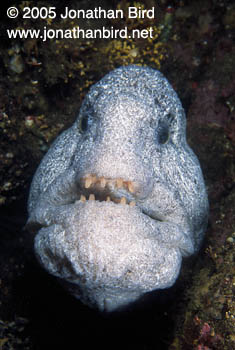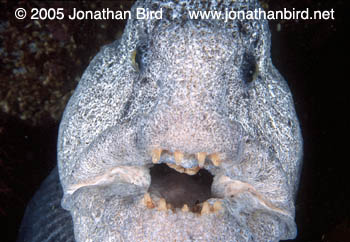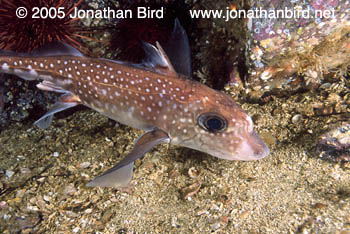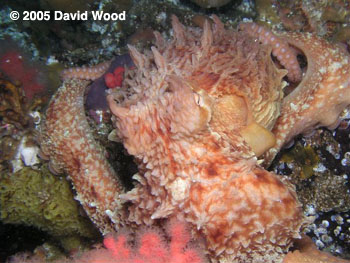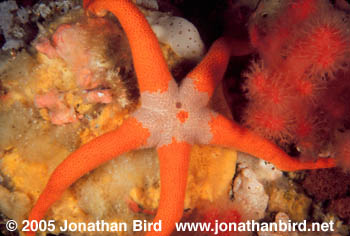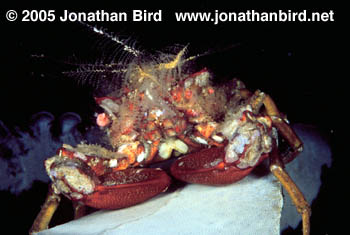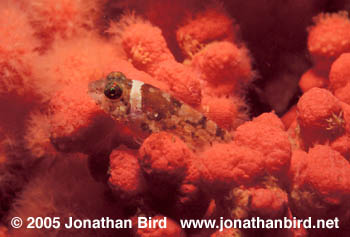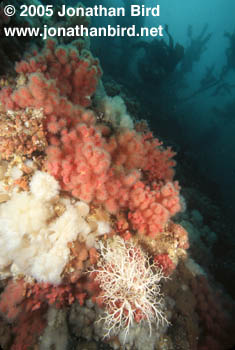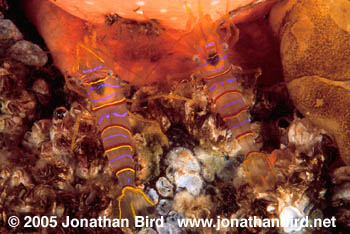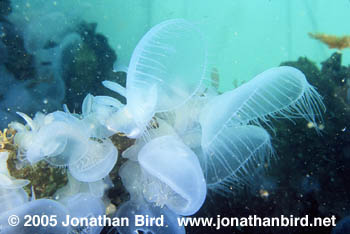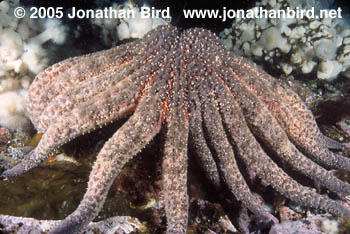
|
September, 2005 It could have been a disaster. I booked the small liveaboard boat Mamro for a dive adventure with 5 friends (David, Carl, Pierre, Brandy and Tim) and we planned to spend a week on a small boat living the good life, diving cold water and seeing all the things BC is known for. Captain Dan Ferris operates Mamro out of Port Hardy, the critter and color capital of BC diving. Two weeks before the trip, Dan e-mailed to tell me that the Mamro engine blew up and he couldn't get it fixed in time for our trip. Was this the end? Would our heroic divers have to bag out? No! As it turned out, Dan's good buddy Chris who operates the M/V Sea Venture had moved up to a bigger boat, the Songhee, and had space for us. We were a little concerned about being shacked up with another group we didn't know, but the alternative was to cancel the trip, and none of us wanted that. Then more tragedy struck. Tim e-mailed me 4 days before the trip to say he was sick and wouldn't be able to make it. I frantically tried to fill his spot, but with only 4 days, I couldn't find anyone. Several people called and contemplated it in response to my urgent e-mails, but alas nobody took me up on the offer of a significantly discounted last minute spot. As you will read..you people (and you know who you are Kerry, Gator and Jenny) missed out on an incredible trip. So our reduced gang of 5 flew into Vancouver and met up at the airport. We all had a fairly smooth flight and all the bags showed up except one. (Mine, of course--containing enough gear that I wouldn't be able to dive! ) After making arrangements to have the bag flown to Port Hardy when it arrived, we picked up our minivans and headed out. We decided to drive to Port Hardy so we could see Vancouver Island and sightsee a bit. First we took a Ferry ride (about 2 hours) from Vancouver (the city) to Vancouver (the island) and into the city of Nanaimo. Next we made the 4 hour drive from Nanaimo through the city of Campbell River and on to Port Hardy, at the northwest tip of the island. We only had one small run-in with the law that I'm allowed to mention. Seems our lead-footed female driver Brandy attracted the attention of the local constabulatory and got herself busted for $125! (Honestly, I was ahead of her so I have no idea why he didn't get me.) We arrived in Port Hardy after a long day...8 hours of flying and 6 hours of driving. By the time Dan met us at the dock, I had been awake for 23 hours, as had the other east coasters. We were beat. After a one hour ride in the "skiff" (more like a small boat) out to the liveaboard, we got a glimpse of our home for a week: clam cove. The big boat, the Songhee, is a 100 foot wooden boat built for the Canadian Coast Guard in 1944. It was beautifully appointed, large, comfortable and very quiet at night. The wood contruction means noise doesn't carry that well through the boat. It was a welcome change from typical steel vessels where the noise of the generator is overwhelming throughout the entire ship. The Songhee was anchored in clam cove, as still as a pond, and all diving would be done by skiff. The following morning we met up with the other group. Among them was David Hall, a well known underwater photographer who I had never met. What a great coincidence! I wasted no time in hitting him up for advice on what to find and where to find it. He was very generous with his knowledge, and helped me get some good shots. While this was my first trip to BC, it was his 6th! The group did several dives the first day, but I concentrated on topside photography. You might think this was because I am very meticulous and wanted to get all my land photography done so I didn't have to worry about it for the rest of the week. Of course, that's what I would like to tell you, but in fact my gear hadn't arrived yet. I couldn't dive. Fortunately, the gear arrived in Port Hardy, flown in on a small airplane that afternoon. They put it on a water taxi and sent it out to me that afternoon and I made my first BC dive that night. So let's see, I did my first dive in BC in 48 degree water, in current, in total darkness, in a brand new drysuit. Sound like a good idea? Nope, it really wasn't. Fortunately, I had no issues and it was a great dive. My first experience with BC diving wasn't as extreme as some others in the group that were new to cold water and drysuits. I frequently dive in the chilly water of northern Maine where we have nasty current and extreme tides. The entire experience was very much like Maine. The coastline looks like Maine, the water looks like Maine and the temerature is like Maine. In spite of the exaggerated claims of 80 foot viz, which is often perpetuated with regards to BC diving, the vis was about the same as Maine too, about 30 feet. What made it different was a whole new cast of characters--different fish, different invertebrates and lots of Bull Kelp. Rather than attempt to list all the great sites we did and all the great stuff we saw, I'm going to just be general. Most of the sites in Port Hardy area are similar. They are characterized by kelp in the shallows, a steep drop-off (sometimes vertical) covered in life, and abysmally deep water beyond that. The 15-40 foot depths are covered in so many metridium anemones that it looks like snow has fallen on the dive site. Deeper, you encounter the larger metridium anemones called plumose anemones. These are the tallest anemones in the world, reaching 3 FEET high. In fact, BC is a land of superlatives when it comes to size. Sometimes, size does matter. I mean, they have foot-long freakin' nudibranchs in this place! The largest nudibranch in the world is the Orange-peel nudibranch, found on virtually every dive. We also saw the Giant Sunflower Star, the largest sea star in the world, the Giant Pacific Octopus (yep, world's largest) and of course, the Wolf "eel" --the largest blenny in the world. Since the Pacific Wolf "eel" is not an eel at all but a fish (a big ass blenny! I'm not making this up!) I have decided to start calling it by it's proper name...the Wolf Blenny. About the Giant Pacific Octopus (GPO from now on): they are not as common as you might expect. I'm told that there are plenty around but they camouflage so well they are hard to find. This might be true. We only saw one in a week and yours truly managed to miss the damned thing. It turns out that the Port Hardy area is not really the best location for seeing GPOs. Puget sound is better. Other than that small dissappointment, we were delighted to see plenty of Wolf Blennies at the wreck of the Themis. We hunted the not-so-elusive Clown Shrimp hiding among Scarlet anemones at Browning wall (my favorite dive...more on this later) and stalked the Spotted Ratfish at night at Frank's Cove. We also visited several famous dive sites such as Seven Tree island (a nice story from Howard Hall about it here), Northwest Passage wall, and Hunt Rock. Hunt Rock was not that exciting. It was known for two friendly wolf blennies called Hunter and Huntress but they are gone. By far the best dive in my humble opinion is the amazing wall dive known as Browning wall where we saw everything imaginable except Wolf blennies. Browning wall starts as a vertical wall of rock rising out of the water, with trees above it, branches hanging down into the water. Under water, it's the same thing...a vertical rock wall going straight down into 300+ feet of water. It's like Cayman, except cold as hell, and honestly, more colorful. The walls are covered in a dozen species of anemones, schools of various species of rockfish, huge areas of pink soft coral, skulpins, basket stars, shrimp and crabs. It's macro heaven. On one dive I managed to kill a 36 exposure roll in 10 minutes on nothing in particular. (I often shoot a whole roll on a subject if I find the right subject that is cooperating, but casually shooting a whole roll on various subjects without even realizing it doesn't happen to me often.) Since I usually finish the dive when I'm out of film, I just took my time and did a nice dive after that. Because of the strong currents in BC, most dives are done at slack: the time when the tide slows down before changing direction. Still, the water is rarely completely slack. Most dives have a bit of current. Rather than fight it, we just drifted along like we were in Cozumel. At the end of the dive, we each surfaced when we were ready and Dan came to pick us up. Because the bays and coves are so protected, the water surface is generally calm even if the current is running. Being seen by the boat captain is not hard and getting in and out of the water is as easy or easier than Caribbean diving. But the water temperatures are very different. This is definitely drysuit territory. I wouldn't even consider diving BC with a wetsuit. With water at 45-48 degrees F at the surface, you need not only a drysuit but good thick undergarments for it. I found myself pretty comfortable for hour long dives with a heavy undergarment and a compressed neoprene drysuit. Brandy was cold at the end of her dives with a thinner undergarment and trilaminate suit. Typically however, you will end a dive because of a strong urge to urinate. Maybe I need to think about adding that "pee" valve! I found myself rationing the drinks at mealtime so I wouldn't spend the whole next dive with my legs crossed. This is probably not a good recipe for diving--staying dehydrated so you don't have to pee! Our group had a ton of fun. Since it was only 5 of us diving from a skiff, we developed a few good inside jokes, and competed for finding the coolest stuff. (I usually lost!) We watched South Park (of course) to the horror of the Canadians aboard. The meals were fabulous, cooked up by "Bee" who cooks like nobody's business. There was not just a lot of food, but it was particularly delicious. This was aided by the fact that Pierre, our resident expert on wine, brought along half a dozen expensive French wines on the trip so we had a different bottle to try each night. David made me jealous with his digital camera that can take 4 zillion pictures without running out of film and he got some good ones. (Check out the GPO shot here!) Pierre was working on a video for a dive travel series for French-speaking markets and got plenty of material, although I still think he needed to go closer on that Wolf blenny. Brandy had both a still and a video camera, not too ambitious there. She gave me her video camera on one dive when I was out of film and being the technical guy I am, I couldn't figure out how to turn the damned thing on. Carl on the other hand, had a nice simple camera system that was a large as the boat, with HID lights, etc. The first time the captain handed it to him, I expected to see Carl vanish from sight, sinking like a stone under the crushing weight. One afternoon we headed over to Husser Cove to look for Melibe (hooded) nudibranchs on the kelp. According to Dan, they would be visible from the surface. Didn't see any. Hmmm, he said, they must not be here yet. On the way back to the Songhee we heard over the radio that Howard Hall and his crew was steaming towards us with the big 3D Imax camera and would be in the Port Hardy area on another boat for 3 weeks filming sequences for his next big 3D Imax film. Over the radio, they asked if anyone had seen any Melibe "nudies" around. We looked at each other, thinking, poor Howard, he won't get the Melibes. The next day, Howard's long-time assistant Bob Cranston came over to the Songhee for a tour and invited us over to his boat for a beer the next day. I asked him if he found any Melibe nudibranchs and he said "yeah, we found a few." So we decided to go have a look the next day. We went back to the cove, splashed into the water and headed for the bottom. About 5 feet from the surface we could see that the entire sea floor was alive with millions of pure white Melibe nudies. We're talking Melibe orgy here. Imagine--we had looked at this a day earlier and decided they weren't there! Apparently they decided to stay deeper rather than climb the kelp to the surface. Another roll of film done in 10 minutes. Now what to do? We pulled up to Howard's boat and Michele came out. I yelled hello and she had a puzzled look for a minute until she realized that she knew me. "Jonathan!? What the heck are you doing here?" What a coincidence. Every time I'm in L.A. I try to hook up with Howard and Michele for dinner and they are always off shooting someplace. Then I bump into them in Port Hardy, 3000 miles from my house, 2000 miles from theirs. Michele was kind enough to invite us over so we could meet the crew and see the Imax camera. Of course we had to get our picture taken with Howard, Michele and Bob Cranston in front of the Imax camera. I even finally got to meet rebreather guru Mark Thurlow. (Mark provided me with an oxygen rebreather to use when I was filming Endangered Mermaids in 1999, but I had never met him in person). A very enjoyable surprise. Alas, the end of the week came and we had to go home. We did about 20 dives in BC and it's a fair amount of work diving over and over in cold water, with all the drysuit donning, but I will definitely be back. The diving is worthy of the praise given to BC. We got a water taxi back to the dock in Port Hardy, had some lunch, and hit the road. We stopped overnight in Nanaimo, so we could rest and have dinner. The next morning we took the ferry to Vancouver and got on our planes without getting busted again. When I got home, the airlines lost my luggage. There's a surprise! For more pictures, use the image search engine and do a search for "British Columbia" under the Location tab. |
|
Last Update 9/27/05


